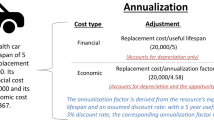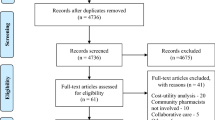Summary
Application of pharmacoeconomic principles to local settings requires an understanding of the subject matter of pharmacoeconomics. Pharmacoeconomics is the application of economics to the evaluation of healthcare interventions. It seeks to broaden the rational scientific basis for making choices between alternative forms of healthcare interventions by capturing and relating their costs and outcomes. Capturing costs requires addressing each form of cost and where they fall. An outcome of treatment implies a change in health status which can be identified and measured using health outcome instruments. Combining costs and outcomes in an analysis will indicate whether a particular healthcare intervention represents good value for money. The type of analysis used to relate costs and outcomes (e.g. cost-minimisation, cost-effectiveness, cost-benefit, cost-utility) will depend on the number, magnitude and distribution of the outcomes.
Pharmacoeconomic analysis can, and should, form part of clinical trials comparing different forms of treatment intervention, considering that the efficiency of a healthcare intervention in practice may differ from its apparent efficacy in the clinical trial. Pharmacoeconomic principles can also be applied to clinical dilemmas using modelling techniques that do not involve studying patients directly. Future costs and benefits can be brought to present-day values using the method of discounting. Sensitivity analysis allows the ‘crystal ball’ to be applied to a variety of local settings.
This paper enables those who are faced with pharmacoeconomic assessments to be more vigilant and critical of the techniques used and the assumptions made. This paper also leads to a wider recognition of the importance of economics in clinical decision-making and encourages the incorporation of pharmacoeconomic analysis into the options available.
Throughout the paper, emphasis is placed on offering insight and inspiration to the tools, tips and traps of applying pharmacoeconomics to local settings. Examples from the published literature are used to signal the relevance and importance of pharmacoeconomics.
Similar content being viewed by others
References
Rogers SL, Freidhoff LT, Donepezil Study Group The efficacy and safety of donepezil in patients with Alzheimers disease: results of a US multicentre, randomized, double-blind placebo-controlled trial. Dementia 1996; 7: 293–303
Bowling A. Measuring disease. Philadelphia: Open University Press, 1995
Collaborative Group on Hormonal Factors in Breast Cancer. Breast cancer and hormonal contraceptives: collaborative re-analysis of individual data on 53,297 women with breast cancer and 100,239 women without breast cancer from 54 epidemiological studies. Lancet 1996; 229(347): 1713–27
Mucklow JC, Haycox AR, Wood KMG, et al. Cost-effective management of dyspepsia. Br J Med Econ 1996; 10 (Pt 2): 119–27
McKell D, Stewart A. A cost-minimisation analysis comparing topical versus systematic NSAIDs in the treatment of mild osteoarthritis of the superficial joints. Br J Med Econ 1994; 7: 137–46
Green JRB, Bate CM, Copeman MB, et al. A comparison of the cost-effectiveness of omeprazole and ranitidine in reflux oesophagitis? Br J Med Econ 1995; 8 (Pt 3): 157–69
O’Brien BJ, Novosel S, Torrance G, et al. Assessing the economic value of a new antidepressant: a willingness to pay approach. Pharmacoeconomics 1995; 8(1): 34–45
Robinson R. Cost-benefit analysis. BMJ 1993; 307: 924–6
Kennedy W, Reinharz D, Tessier G, et al. Cost-utility of chemotherapy and best supportive care in non-small cell lung cancer. Pharmacoeconomics 1995; 8(4): 316–23
Severo CA, Fagnani F, Lafuma A. Cost effectiveness of Hepatitis A prevention in France. Pharmacoeconomics 1995; 8(1): 46–61
Stewart A, Powles R, Hewetson M, et al. Costs of antifungal prophylaxis after bone marrow transplantation: a model comparing oral fluconazole, liposomal amphotericin and oral polyenes as prophylaxis against oropharyngeal infections. Pharmacoeconomics 1995; 8(4): 350–61
Epstein RS, McGlynn MG. Disease management: what is it? Dis Manage Health Outcomes 1997; 1(1): 3–10
Aristides M, Mitchell AS, Henry DA. Developments in economic evaluation: the subsidization of pharmaceuticals In: Davis P, editor. Contested ground: public purpose and private interest in the regulation of prescription drugs. New York: Oxford University Press, 1996: 207–20
Drummond MF, Richardson WS, O’Brien BJ, et al. Users guide to the medical literature: how to use an article on economic analysis of clinical practice: are the results of the study valid? JAMA 1997: 277(19); 1552–7
Grabowski H. The effect of pharmacoeconomics on company research and development decisions. Pharmacoeconomics 1997; 11(5): 389–97
Guyatt GH, Naylor CD, Juniper E, et al. Users guide to the medical literature: how to use an articles about health related quality of life. JAMA 1997: 277(15); 1232–7
Horn SD. Tools and techniques in disease management: programmes for improving and measuring outcomes. Dis Manage Health Outcomes 1997; 1(1): 17–25
Todd WE, Eichert JH, Toscani MR. Disease management: building a solid foundation. Dis Manage Health Outcomes 1997; 1(1): 26–33
Author information
Authors and Affiliations
Corresponding author
Additional information
About the Authors: Alan S.M. Earl-Slater is Senior Lecturer in Health Economics in the Department of Medicines Management at Keele University, Staffordshire, UK. He previously worked at Birmingham and Oxford. His main research interest is the application of economics to the pharmaceutical environment including government policy, business strategy and value for money studies.
John C. Mucklow is Consultant Physician and Clinical Pharmacologist at North Staffordshire Hospital NHS Trust, Stoke-on-Trent, and Senior Lecturer in Clinical Pharmacology and Therapeutics in the Department of Medicines Management, Keele University, Staffordshire, UK. His main interest is postgraduate education in therapeutics for health professionals in primary and secondary care.
James N.R. Bashford is a senior partner in General Practice in Trent Vale, Stoke-on-Trent, and Lecturer in Primary Care Research in the Department of Medicines Management, Keele University, Staffordshire, UK. His main interests are the management of asthma and the development of a network of general practitioner researchers.
Jonathan R.B. Green is Consultant Physician and Gastroenterologist at North Staffordshire Hospital NHS Trust, Stoke-on-Trent, and Senior Clinical Lecturer in the Department of Medicine, Keele University, Staffordshire, UK.
Rights and permissions
About this article
Cite this article
Earl-Slater, A.S.M., Mucklow, J.C., Bashford, J.N.R. et al. How to Apply Pharmacoeconomic Principles to Local Settings. Dis-Manage-Health-Outcomes 2, 65–76 (1997). https://doi.org/10.2165/00115677-199702020-00002
Published:
Issue Date:
DOI: https://doi.org/10.2165/00115677-199702020-00002




